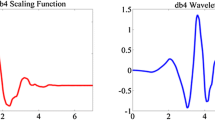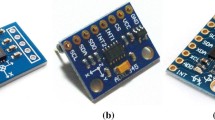Abstract
The detection of the engine rotational speed in revolutions per minute (RPM) is of great importance to estimate the speed of boats. This value can be obtained from the fundamental frequency component of acquired sonar signals. However, detection can often be seriously affected by noise and distortion introduced by the underwater environment. Several methods have been proposed for fundamental component detection, but they do not specifically take advantage of the passive sonar signal characteristics to improve the performance of the process. In this context, the proposed algorithm uses DEMON processing applied to wavelets packets subbands to exploit the characterization of the sonar signal in the time and frequency domains. The algorithm involves signal segmentation, wavelet packet decomposition, subband envelope cross-correlation and fundamental component detection from the power spectrum. The method was applied in passive sonar signals acquired in navigation and also obtained by simulation. The performance of the proposed algorithm was evaluated with signals of different SNR values that were also corrupted by a simulated multipath underwater channel. The signals were evaluated by both the experienced sonar operators and the proposed algorithm. The results obtained were very satisfactory for RPM detection and are detailed at the end of this document.
























Similar content being viewed by others
References
Hanson D, Antoni J, Brown G, Emslie R (2008) Cyclostationarity for passive underwater detection of propellor craft: a development of DEMON processing. Acoustics—AAS 2008. Geelong, Victoria
Gerhard D (2003) Pitch extraction and fundamental frequency history and current techniques. Technical Report TR-CS 2003-06, University of Regina, Canada, Department of Computer Science
Jouvet D, Laprie Y (2017) Performance analysis of several pitch detection algorithms on simulated and real noisy speech data. In: 25th European signal processing conference (EUSIPCO), Kos, Greece, 28 Aug–2 Sept 2017
Antoni J (2009) Statistical threshold for blind underwater detection of propellor craft using cyclostationarity. The Sixteenth International Congress on Sound and Vibration, Krakow
Pollara AS (2017) Specifics of DEMON acoustic signatures for large and small boats. J Acoust Soc Am 141(5):3991–3991
Chung K, Sutin A, Sedunov A, Bruno M (2011) DEMON acoustic ship signature measurements in an urban harbor. Advances in Acoustics and Vibration
Brinkmann K, Hurka J (2010) Narrowband passive sonar tracking. In: Lecture notes in informatics—INFORMATIK 2010, Proceedings, p 176
Ogden GL, Zurk LM, Jones ME, Peterson ME (2011) Extraction of small boat harmonic signatures from passive sonar. J Acoust Soc Am 129(5):3768–3776
Aunsri N (2016) A bayesian filtering approach with time-frequency representation for corrupted dual tone multi frequency identification. Eng Lett IAENG 24(4):370–377
Kemper G, Iano Y (2011) An audio compression method based on wavelets subband coding. IEEE Lat Am Trans 9(5)
Katsnelson B, Petnikov V, Lynch J (2012) Fundamentals of shallow water acoustics, vol 21. Springer, Boston
Zhou S, Wang Z (2014) OFDM for underwater acoustic communications. Wiley, Chichester
Cheng X, Yang L, Cheng X (2016) Cooperative OFDM underwater acoustic communications. Springer International Publishing, Berlin
Stojanovic M (2008) Underwater acoustic communications: design considerations on the physical layer. In: Fifth annual conference on wireless on demand network systems and services
Stojanovic M, Preisig J (2009) Underwater acoustic communication channels: propagation models and statistical characterization. IEEE Communications Magazine
Author information
Authors and Affiliations
Corresponding author
Additional information
Publisher's Note
Springer Nature remains neutral with regard to jurisdictional claims in published maps and institutional affiliations.
Rights and permissions
About this article
Cite this article
Kemper, G., Ponce, D., Telles, J. et al. An Algorithm to Obtain Boat Engine RPM from Passive Sonar Signals Based on DEMON Processing and Wavelets Packets Transform. J. Electr. Eng. Technol. 14, 2505–2521 (2019). https://doi.org/10.1007/s42835-019-00260-4
Received:
Revised:
Accepted:
Published:
Issue Date:
DOI: https://doi.org/10.1007/s42835-019-00260-4




